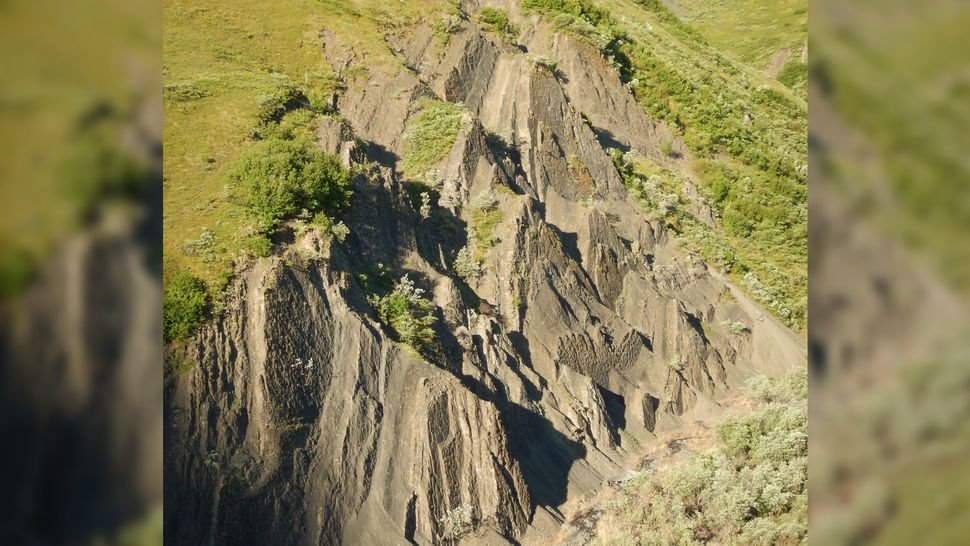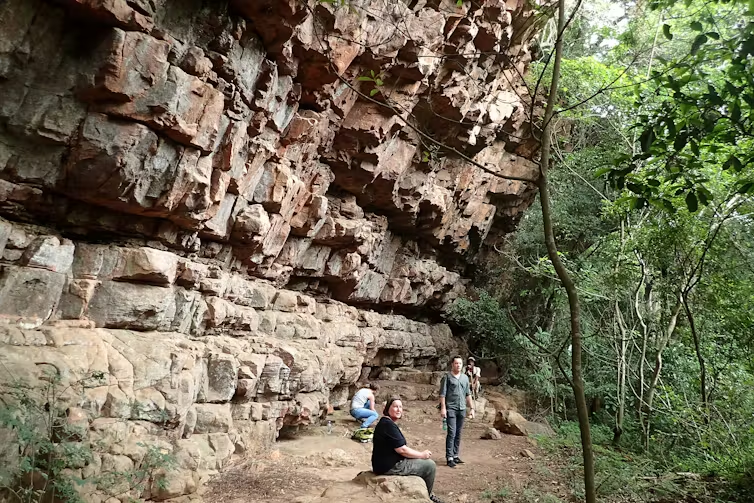In Alaska, a 20-story rock face known as "The Coliseum" is covered in numerous layers of dinosaur footprints, including a tyrannosaur.
The cliff face, known as "The Coliseum," in Denali National Park and Preserve. Its surface is covered in fossilized dinosaur tracks. (Image credit: Patrick Druckenmiller)
The wall of a 20-story cliff in Alaska is covered in the fossilized footprints of dozens of dinosaurs, giving the impression that the animals defied gravity to walk across its surface, but a geological process is actually to blame. This discovery has "flabbergasted" researchers who have been studying the area.
Currently, the rock face in Denali National Park and Preserve rises at a height of around 218 feet (66 meters). But in the late Cretaceous, some 70 million years ago, the rock was muddy muck that probably surrounding a watering hole on a huge floodplain. This explains the wide range of dinosaur footprints found on the cliff face, including those of young dinosaurs and adults of several big, plant-eating, duck-billed, and horned dinosaurs, as well as carnivores like raptors, nonavian flying reptiles, and at least one tyrannosaur.
The tracks were hauled up and deposited on their side as the ground bulged upward during a tectonic plate collision, similar to how the bonnet of a car folds under the force of a collision, long after the dinosaurs had left their mark in the region. According to the National Park Service, this tectonic activity was a component of the geological turbulence that gave rise to the 600-mile-long (966-kilometer) Alaska Range next to Denali National Park.
A 3D reconstruction of a suspected tyrannosaur footprint discovered at The Coliseum. (Image credit: Dustin Stewart)
Due to the variety of dinosaurs that probably interacted with one another near the water's edge, the location has been given the moniker "The Coliseum" by researchers. The journal Historical Biology released the team's analysis of the site on July 27, 2023. The word "coliseum" refers to a theater, stadium, or other sizable public area.
A seven-hour hike from the closest road separates the cliff from the remainder of a vast rocky outcrop. Due to the fact that most of the footprints had been filled in by other sediments, prior researchers who found a set of tracks at the base of the cliff missed the intricate patchwork of footprints that was looming above them. However, when their colleagues arrived at the location, they discovered the covert tracks.
According to research co-author Pat Druckenmiller, a vertebrate paleontologist at the University of Alaska Fairbanks and curator at the University of Alaska Museum of the North, "When we first went out there, we didn't see much either." However, in a particular setting, the imprints were much easier to see.
Dustin Stewart, a paleontologist at Paleo Solutions and a former student at the University of Alaska Fairbanks, was the study's primary author and said in a statement, "When the sun angles itself perfectly with those beds, they just blow up." Immediately, he continued, "all of us were just flabbergasted." "We were panicking."
The Coliseum is part of an even larger rocky outcrop. The cliffs were lifted into the air by a tectonic plate collision. (Image credit: Patrick Druckenmiller)
The scientists noticed that the imprints were remarkably precise upon closer examination. Druckenmiller declared, "They are lovely." "You can see the skin's texture and the toes' shape."
The traces that were laid beneath those on the rock's surface were also found by the researchers.
Stewart remarked, "It's not simply one level of rock with tunes on it. It is a chronological progression. There have been other dinosaur footprints discovered in Denali National Park, but "nothing of this magnitude," he continued.
Along with petrified vegetation, pollen, and crustaceans, the cliff also has bird tracks from wading. The findings, according to the researchers, will enable them to create a thorough picture of the environment 70 million years ago. According to Stewart, "all these little hints put together what the environment looked like overall."








